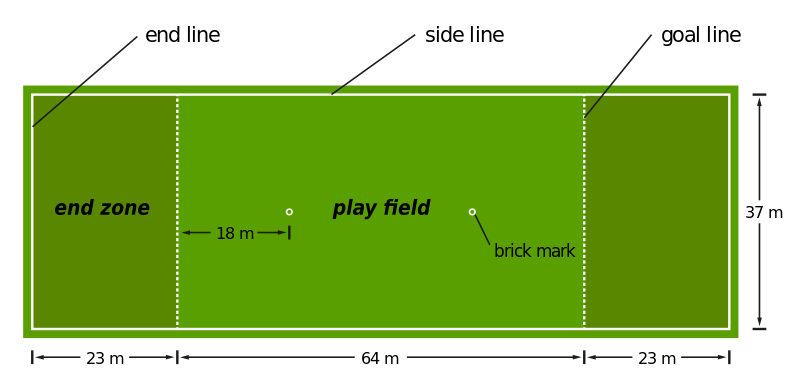Steve Courlang and Neal Dambra
Copyright (c) Ultimate Players Association, 1993
- The Field — A rectangular shape with endzones at each end. A regulation field is 70 yards by 40 yards, with endzones 25 yards deep.
- Initiate Play — Each point begins with both teams lining up on the front of their respective endzone line. The defense throws (“pulls”) the disc to the offense. A regulation game has seven players per team.
- Scoring — Each time the offense completes a pass in the defense’s endzone, the offense scores a point. Play is initiated after each score.
- Movement of the Disc — The disc may be advanced in any direction by completing a pass to a teammate. Players may not run with the disc. The person with the disc (“thrower”) has ten seconds to throw the disc. The defender guarding the thrower (“marker”) counts out the stall count.
- Change of possession — When a pass in not completed (e.g. out of bounds, drop, block, interception), the defense immediately takes possession of the disc and becomes the offense.
- Substitutions — Players not in the game may replace players in the game after a score and during an injury timeout.
- Non-contact — No physical contact is allowed between players. Picks and screens are also prohibited. A foul occurs when contact is made.
- Fouls — When a player initiates contact on another player a foul occurs. When a foul disrupts possession, the play resumes as if the possession was retained. If the player committing the foul disagrees with the foul call, the play is redone.
- Self-Refereeing — Players are responsible for their own foul and line calls. Players resolve their own disputes.
- Spirit of the Game — Ultimate stresses sportsmanship and fair play. Competitive play is encouraged, but never at the expense of respect between players, adherence to the rules, and the basic joy of play.
Text mirrored from:
http://www.cs.rochester.edu/u/ferguson/ultimate/ultimate-simple.html
